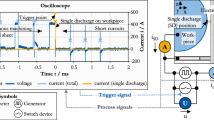Abstract
In wire electrical discharge machining (wire-EDM) material is removed by the thermal energy of an electric spark that has been initiated between two electrodes (the wire and the workpiece), submerged in demineralised water. The use of high frequency current pulses for sparking leads to excellent machining performance, in terms of the work piece roughness, the material integrity of the cut and the material removal rate. To reach the highest frequencies, the wire-EDM generator mostly consists of a voltage source with an as low as possible internal inductance. The working current delivered to the spark and, hence, the material removal rate of the process depends on the total impedance of the electrical circuit. In this article the importance of the wire’s impedance will be shown. Due to the skin-effect, this impedance depends on the frequency of the current signal, especially for ferromagnetic wires, such as steel wire. Coatings will prove to be primordial to prevent the machining speed from dropping significantly.




Similar content being viewed by others
Abbreviations
- U H ::
-
Ignition voltage source (V)
- U L ::
-
Burning voltage source (V)
- U::
-
Spark’s voltage signal (V)
- I::
-
Spark’s current signal (A)
- S 1, S 2::
-
Generator switches
- D 1, D 2, D h: :
-
Generator diodes
- R H , R w ::
-
Generator resistors (Ω)
- R 0::
-
Wire’s resistance at D.C. (Ω/m)
- R::
-
Wire’s resistance at 100 kHz (Ω/m)
- L s ::
-
Generator inductance (H)
- J::
-
Current density (A/m2)
- r::
-
Radial co-ordinate
- r o: :
-
Outer radius (m)
- r i ::
-
Inner radius (m)
- A::
-
Current pulse rise time (μs)
- t d ::
-
Pulse ignition delay time (μs)
- t e ::
-
Pulse time (μs)
- t o ::
-
Pulse offtime (μs)
- π::
-
3,1415...
- ν::
-
100 kHz; groundfrequency spark’s current signal (Hz)
- μ r ::
-
Magnetic permeability of the medium
- μ 0::
-
Magnetic susceptibility of vacuum=4π.10−7 (H/m)
- μ::
-
=μ r μ 0
- σ::
-
Electrical conductivity (S/m)
- L::
-
Wire’s inductance at 100 kHz (H/m)
- L 0::
-
Wire’s inductance at D.C. (H/m)
- P x: :
-
Joule Power dissipated in x (W)
References
Wollenberg G, Shulze H-P, Pape T, Läuter M (1999) Moderne Generatortechnik für die funkenerosive Bearbeitung. In: 4. Aachener Fachtagung Funkenerosive Bearbeitung, ADITEC, Aachen, Germany, 1999
Balleys F, Piantchenko C (1996) Surface integrity of materials machined by wire EDM machines. EDM Tech Trans 4:3–6
Nijs K, Persoons M (2002) Influence of wire-electrode materials on the performance of wire electrical discharge machining. Master’s thesis, Katholieke Universiteit Leuven (in Dutch)
Geysen W, Belmans R (1993) Algemene Elektrotechniek. Garant, Belgium
Kruth J-P, Lauwers B, Schacht B (2001) Increasing precision of wire electrical discharge machining by using coated steel electrodes. In: Proceedings of the 19th Science and Technology Conference, Mechanical Engineering, Hanoi, Vietnam, 10–15 October 2001
Schacht B, Bleys P, Kruth J-P, Gonnissen D, Van Vooren W (2001) Influence of coated steel wire on the machining performance of W-EDM. In: Proceedings of the 13th International Symposium for Electro-Machining, Bilbao, Spain, 9–11 May 2001
Delpretti R (1977) Physical and chemical characteristics of the superficial layers. In: Proceedings of the 5th International Symposium for Electro-Machining, Wolfsberg, Switzerland, 1977
Hensgen G (1984) Werkzeugspezifische Einflüsse beim funkenerosiven Schneiden mit ablaufender Drahtelektrode. Dissertation, RWTH Aachen
Sho H, Orimo T, Fukui M (1989) The effect of electrode materials on the characteristics of machinability of wire electro-discharge machines. In: Proceedings of the 9th International Symposium for Electro-Machining, Nagoya, Japan, 10–14 April 1989
Dekeyser W (1988) Knowledge-based system for wire-EDM. Dissertation, Katholieke Universiteit Leuven
Acknowledgements
The authors acknowledge the support of Charmilles Technologies s.a. and Bekaert n.v., and would like to thank them for putting the wire electrical discharge machine and the steel wires at their disposal for scientific research. The authors would also like to thank K. Nijs and M. Persoons for their initial research in this field, described in their master’s thesis [3]. The research was also partially funded by the scholarship of the Flemish Institute for the Promotion of Scientific Technological Research in Industry (IWT), granted to B. Schacht.
Author information
Authors and Affiliations
Corresponding author
Rights and permissions
About this article
Cite this article
Schacht, B., Kruth, JP., Lauwers, B. et al. The skin-effect in ferromagnetic electrodes for wire-EDM. Int J Adv Manuf Technol 23, 794–799 (2004). https://doi.org/10.1007/s00170-003-1654-6
Received:
Accepted:
Published:
Issue Date:
DOI: https://doi.org/10.1007/s00170-003-1654-6




